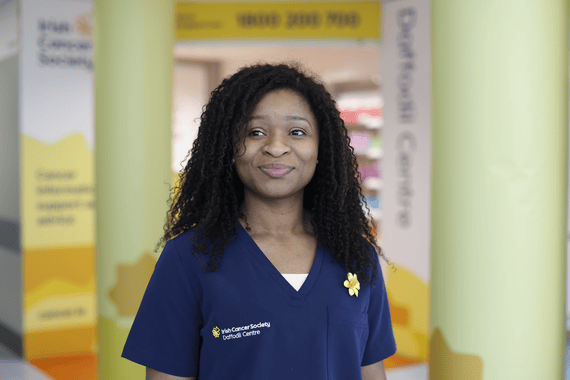Oesophageal cancer
Diagnosis and tests
Diagnosing oesophageal cancer
Your family doctor (GP) will talk to you about your symptoms. Your GP will refer you to hospital if they think you need more tests. Tests you might have include:
X-rays are taken of your oesophagus as you drink a white chalky liquid called barium. The liquid shows up any abnormal areas in your oesophagus. This test normally takes about 15 minutes and is not painful. Even though the liquid tastes chalky, it should not make you feel sick.
Read more about having a barium swallow.
A thin flexible tube with a camera and a light is put into your oesophagus so the doctor can check for unusual changes. This test is also called a gastroscopy.
Read more about having an endoscopy.
A device like a microphone passed over the area to give a picture of the tissues inside your body. It can show any abnormal changes.
Read more about liver ultrasound scans.
An ultrasound probe is passed through a tube into your body through your mouth. It can take ultrasound pictures from inside your oesophagus.
Read more about having an EUS.
This means taking a sample of the cells in the oesophagus and looking at them under a microscope. This is usually done during an endoscopy or EUS.
A gastroenterologist is a doctor who specialises in treating problems with the digestive system.
If you have been waiting for longer than 3 months for your endoscopy, contact the National Treatment Purchase Fund (NTPF). This is a scheme set up to reduce waiting times for tests and operations. You may be referred to a private hospital for endoscopy free of charge. For more information, contact 1890 720 820 or visit the website:

If you are diagnosed with oesophageal cancer, we're here for you.
Our cancer nurses are here if you need information or just want to talk. They can help you to understand your diagnosis and what to expect, send you information and tell you about our services.
Further tests for oesophageal cancer
You may need further tests to give your doctors more information about your general health and about the cancer. For example:
A type of X-ray that gives a detailed picture of the tissues inside your body.
Read more about CT scans.
An ultrasound probe is passed through a tube into your body through your mouth. This probe makes sound waves that allow your doctor to see the tissues inside your oesophagus and nearby areas. This can help your doctor assess the size and
depth of the tumour.
They can also check if nearby lymph nodes are enlarged due to cancer or infection.
A sample of the lymph nodes can be taken and examined under a microscope to check for signs of cancer.
Read more about having an EUS.
Blood tests can check your general health, including how well your kidneys and liver are working. They can also check the level of different blood cells and monitor your response to certain treatments.
- Full blood count (FBC): Checks the number of different types of blood cells in your blood.
- Kidney function tests (urea and electrolytes) check how well your kidneys are working.
- Liver function tests (LFT) check your liver’s health.
- Routine blood tests will be done throughout chemotherapy treatment.
- A blood test called a micronutrient screen can check levels of vitamins, minerals and other essential nutrients to see if you have a deficiency.
- Tumour marker blood tests may be done to monitor your response to chemotherapy.
A PET CT scan is a combination of a CT scan and a PET scan. It can show if the cancer has spread to other tissues and organs.
You may have to travel to a specialist centre to have a PET scan, as not every hospital has these scanners.
Read more about PET scans.
Sometimes you will have an MRI scan if your doctors want to have a closer look at areas outside the oesophagus, such as the liver. During the scan you will lie inside a tunnel-like machine.
Read more about MRI scans.
You may have this test if your doctor needs more information after other tests have been done.
A laparoscopy is a small operation that is performed under general anaesthetic. A mini telescope is passed through a small cut in your abdomen (tummy) so that your doctor can see the organs close to your oesophagus and check the lining of your abdomen for cancer.
Your doctor may make another cut in the tummy if a small sample of tissue (biopsy) needs to be taken and checked for cancer.
Your doctor will discuss this test with you if you need it.
Read more about having a laparoscopy.
Lung (pulmonary) function tests can see how well your lungs are working – normally before neo-adjuvant chemotherapy (chemotherapy given before surgery) and again before surgery. For a pulmonary function test (PFT), you blow into a mouthpiece on
a machine. PFTs are not painful and take about 20 minutes.
These tests can see how well your heart is working. They may be used to check your general health or to see if treatment has affected your heart. For example, some chemotherapy drugs can affect the muscles of the heart (this is usually temporary).
The 2 main types of test are:
- ECG: Sensors are attached to your skin that can pick up the signals produced by your heart when it beats.
- Echocardiogram (‘Echo’ scan): This is a type of ultrasound that can produce a moving image of your heart at work and nearby blood vessels to give information about your heart function.
The tests you have can help to stage your cancer. This means finding out the size and position of the cancer.
Some tests may be used see how you are responding to treatment.
Waiting for test results
While some results may come back quickly, others may take a few weeks. Waiting for results can be an anxious time. It may help to talk things over with your doctor or nurse or with a relative or close friend. You can also call our Support Line on 1800 200 700 or visit a Daffodil Centre to speak to a cancer nurse.
What are the stages of oesophageal cancer?
Staging cancer means finding out its size and if it has
spread. Staging helps your doctor to plan the best treatment for you.
TNM staging system
The TNM staging system is often used for oesophageal cancer is called. This stands for:
The size of the tumour and how far it has grown into the lining of the oesophagus. Doctors put a number next to the T to describe the size and spread of the cancer.
This describes whether the cancer has spread to the nearby lymph nodes and how many nodes are affected.
- N0 means there is no cancer in the nodes.
- If cancer has spread to the lymph nodes (positive nodes) the N will have a number to describe how many lymph nodes are affected.
- NX means the doctors cannot tell if the nodes are affected.
This describes if the cancer has spread to another part of the body, such as the liver or lungs. The M may have a number next to it. This gives extra information about where the cancer has spread to.
Number staging
Your doctor often uses the TNM information to give your cancer a number stage – from 1 to 4. A higher number means a more advanced cancer. Some stages are further divided
into stage A and B.
The cancer is at a very early stage. Cancer cells are found in the lining of your oesophagus but are completely within the lining. This stage is also known as carcinoma in situ.
The cancer is at an early stage. The cancer cells are found only in the surface layers of the lining of your oesophagus. Or it may be found in only a small part of your oesophagus. There is no sign of it spreading anywhere.
The cancer has spread to the muscle layer of your oesophagus or to nearby lymph nodes. But it has not spread to any other organs. If the cancer has not spread to nearby lymph nodes, it is stage 2A. If the cancer has spread to nearby lymph nodes, it is stage 2B.
The cancer has spread beyond the wall of your oesophagus. It may also have spread to nearby lymph nodes and other tissues next to your oesophagus. But there are no signs of it spreading to other parts of your body.
The cancer is advanced and has spread to your lymph nodes and other parts of your body. For example, your liver, lungs or stomach. Cancer in another part of your body is called secondary or metastatic oesophageal cancer.
Knowing the stage of your cancer helps your team to plan the best treatment for you. Staging can be hard to understand, so ask your doctor and nurse for more information if you need it.
Continue reading about oesophageal cancer




Get help & support

Support Line
Our Daffodil Centres

